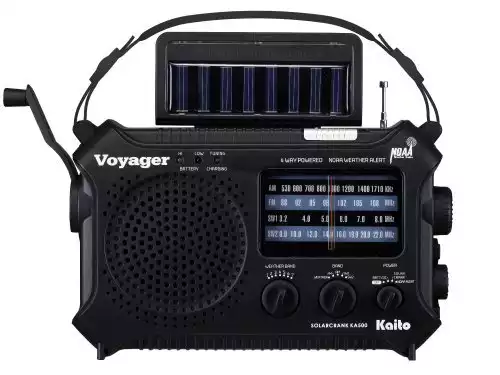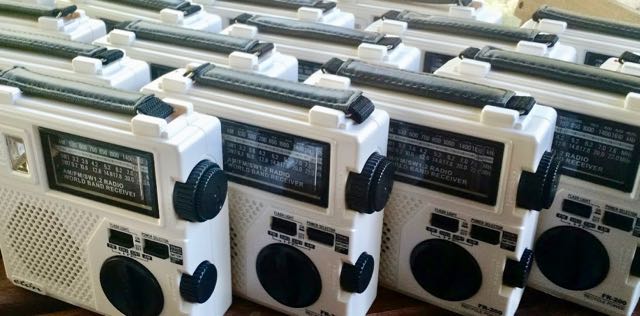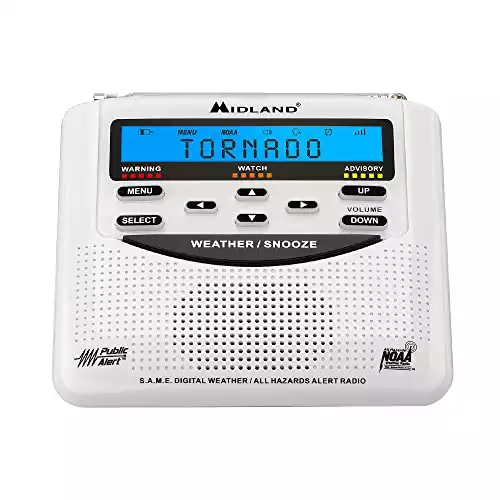Amid the uncertainty that looms over the possibility of a nuclear war, it is natural to ponder the importance of being prepared.
Communication is vital in surviving such catastrophic events; what is the best radio during a nuclear war?

Review contents
Factors to Consider When Choosing a Radio
When choosing a radio, there are several important factors to consider. From frequency bands to battery life, these factors can significantly impact your overall experience and the effectiveness of your radio in different scenarios. Let’s look at these factors to help you make the right choice.
Frequency Bands
One of the first factors to consider when choosing a radio is the frequency bands it can receive. AM/FM radios are the most common and offer access to traditional broadcast stations.
On the other hand, shortwave radios allow you to listen to international broadcasts. They are an excellent option for those interested in staying connected with the world during a nuclear war.
Handheld ham radios provide access to amateur radio frequencies, which can help communicate with other ham radio operators in emergencies. Two-way radios are another option, allowing for direct communication within a specific range.
Battery Life
Another crucial factor to consider is the battery life of the radio. Recharging your radio’s batteries may be difficult or even impossible in a nuclear war scenario.
Therefore, choosing a radio with a long battery life is essential to ensure you can rely on it for extended periods. Look for radios that offer a combination of efficient power consumption and the ability to use rechargeable batteries for added convenience.
Power Source
While battery-powered radios are the most common, it’s also worth considering radios that alternative sources can power. During a nuclear war, electricity may become scarce or unreliable, making it essential to have a radio powered by solar energy, hand cranking, or other renewable methods.
Emergency crank radios, for example, often have a built-in dynamo that allows you to generate power by turning a crank. This can be a lifesaver when traditional power sources are not available.
Size and Portability
The size and portability of a radio are also essential factors to consider. In a nuclear war scenario, you may need to move quickly and always carry your radio.
Therefore, it is advisable to choose a radio that is compact, lightweight, and easy to carry. Portable handheld radios or pocket-sized models are ideal for this purpose, as they can easily fit in your pocket or backpack, allowing you to stay connected no matter where you are.
Durability and Water Resistance
In an emergency like a nuclear war, having a durable radio that can withstand harsh conditions is crucial. Look for radios built to be rugged and resistant to impact, dust, and water.
Water resistance is significant, as you may encounter rain, water leaks, or other wet conditions during your survival efforts. Weather-resistant radios can provide peace of mind, knowing that your radio will continue functioning even in challenging environments.
Range
Another factor to consider is the range of the radio. Depending on your needs, you may require a radio to cover short distances or a more extended range for communication over larger areas.
Two-way radios, for example, often come with different range options, allowing you to choose a model that suits your specific requirements. Consider the maximum range you may need, considering factors such as terrain and obstacles that can affect signal strength.
Signal Quality
The quality of the radio’s signal is paramount, especially in a nuclear war scenario where communication can be limited, and crucial information is at stake. Look for radios with strong receivers that can precisely pick up signals.
Radios with advanced signal processing technology can help eliminate interference and improve the overall signal quality, ensuring you can stay informed and connected when it matters most.
Emergency Alert System
During a nuclear war, it is essential to have a radio that can receive emergency alerts and broadcasts.
Many weather radios are equipped with the NOAA Weather Radio All Hazards (NWR) system, which provides frequent updates on weather conditions and other critical information.
Radios with built-in alert systems can notify you of emergencies, including severe weather, Amber Alerts, and other important announcements. A radio with these features can be a lifesaver in a nuclear war scenario.
Additional Features
Consider any additional features that would be beneficial to have in a radio for a nuclear war scenario. Some radios come with built-in flashlights, solar panels for charging other devices, and even the ability to charge your smartphone.
These features can provide added convenience and functionality, ensuring multiple tools are available during an emergency.
Price
Finally, consider your budget when choosing a radio. While investing in a reliable, high-quality radio is essential, options are available at various prices.
Determine the features and capabilities that are most important to you and find a radio that fits within your budget.
Remember, the ultimate goal is a radio that will serve you effectively during a nuclear war, so choose wisely based on your needs and priorities.
Types of Radios
Now that we have discussed the various factors to consider when choosing a radio let’s explore the different types of radios available. Understanding the differences between these types can help you make a more informed decision and select the best radio for your needs in a nuclear war scenario.
AM/FM Radios
AM/FM radios are the most common type of radio and provide access to traditional broadcast stations. These radios are typically affordable, compact, and easy to use.
While they may not have the same range or advanced features as other radios, they are a reliable option for staying connected to local news, weather updates, and emergency broadcasts during a nuclear war.
Shortwave Radios
Shortwave radios are designed to receive international broadcasts and are a popular choice for those who want to stay connected with the world during a nuclear war.
They offer a wide range of frequencies and can pick up signals from various countries, making them an excellent source of information and updates. Shortwave radios often have more advanced features and capabilities than AM/FM radios but may also be more extensive and expensive.
Handheld Ham Radios
Handheld or amateur radios provide access to specific frequency bands reserved for licensed ham radio operators. They are popular among enthusiasts and can be helpful in communication with other ham radio operators during emergencies.
Handheld ham radios offer more excellent range and flexibility than AM/FM radios but require a legal license.
Two-Way Radios
Two-way radios, or walkie-talkies, allow for direct communication between two or more radios within a specific range. They are commonly used for team coordination during outdoor activities and can be a valuable tool during a nuclear war scenario.
Two-way radios come in different ranges and offer features such as voice-activated transmission and multiple channels for secure communication.
Emergency Crank Radios
Emergency crank radios are designed to be powered by alternative methods such as solar energy or hand cranking. They often come with built-in flashlights and other emergency features, making them a versatile option for survival.
With an emergency crank radio, you can rely on renewable energy sources to stay informed and connected even when traditional power sources are unavailable.
Weather Radios
Weather radios are specifically designed to receive weather alerts and updates from the NOAA Weather Radio All Hazards (NWR) system.
They provide real-time information on severe weather conditions, including tornadoes, hurricanes, and other hazardous events. Weather radios can be crucial for staying informed and prepared during a nuclear war, as they can provide essential warnings and instructions.
Now that we have explored the available radios let’s look at the best radios for a nuclear war scenario. We will categorize them based on the type of radio and provide some recommendations within each category.
Best Radios for a Nuclear War
Choosing the best radio for a nuclear war can be daunting, given the many options available.
We have carefully selected the top radios for each category to simplify the process and provide a brief overview of their features. Remember to consider your specific needs and preferences when making your final decision.
I. AM/FM Radios
AM/FM radios are a fundamental choice for staying connected to local news, emergency broadcasts, and weather updates during a nuclear war. Here are some top recommendations in this category:
a. RadioShack Pocket AM/FM Radio
- Compact and portable design
- Built-in speaker with clear sound quality
- Easy-to-use analog tuning
- It runs on two AAA batteries
b. Sangean PR-D4W Portable AM/FM/Weather Band Radio
- Weather band reception for emergency alerts
- Clear and crisp audio quality
- Multiple preset stations for easy tuning
- Runs on either AC power or 6 AA batteries
c. Sony ICFP26 Portable AM/FM Radio
- Slim and lightweight design
- Excellent reception and sound quality
- Built-in speaker and headphone jack
- It runs on two AA batteries
d. Eton Elite Field AM/FM/Shortwave Desktop Radio
- Exceptional AM/FM and shortwave reception
- Comprehensive frequency coverage for international broadcasts
- Large LCD for easy reading
- Runs on AC power, 6 D-size batteries, or rechargeable batteries
II. Shortwave Radios
Shortwave radios offer a broader range of frequencies and are ideal for those who want to stay connected with international broadcasts during a nuclear war. Here are some top recommendations in this category:
a. Tecsun PL880 Portable Digital PLL Dual Conversion Radio
- Dual speakers for stereo sound quality
- Excellent reception and signal clarity
- Advanced DSP technology for enhanced performance
- It runs on either AC power or a rechargeable battery pack
b. Kaito Voyager Pro KA600 Digital Solar Dynamo Crank Wind Up AM/FM/LW/SW & NOAA Weather Emergency Radio
- Multiple power options, including solar, hand crank, and AC adapter
- NOAA weather alerts and AM/FM/SW/LW reception
- Built-in flashlight and reading lamp
- Rechargeable battery and smartphone charging capabilities
c. C. Crane CC Skywave SSB AM, FM, Shortwave, NOAA Weather + Alert, Scannable VHF Aviation Band and Single Side Bands Small Battery Operated Portable Travel Radio
- Wide range of frequency coverage
- Exceptional audio quality and sensitivity
- Single sideband (SSB) reception for long-range communication
- Runs on two AA batteries or an external power source
d. Sony ICF-SW7600GR AM/FM Shortwave World Band Receiver with Single Side Band Reception
- Solid performance with excellent sensitivity and selectivity
- Dual conversion technology for improved reception
- Multiple tuning options, including direct frequency entry
- It runs on four AA batteries or an AC adapter
III. Handheld Ham Radios
Handheld ham radios can communicate with other operators and emergency services during a nuclear war. Here are some top recommendations in this category:
a. Baofeng UV-5R Dual Band Two-Way Radio
- Dual-band functionality for increased versatility
- Programmable channels and frequencies
- Long battery life and high-power output
- Compact and lightweight design
b. Yaesu VX-6R Tri-Band Submersible Amateur Handheld Transceiver
- Tri-band operation (2m, 222 MHz, 440 MHz)
- Water and dust resistance for durability
- Wide range of features, including built-in flashlight and NOAA weather alerts
- Long-lasting battery and convenient charging options
c. BTECH UV-5X3 5 Watt Tri-Band Radio
- Tri-band operation (2m, 1.25m, 70cm)
- Dual PTT for simultaneous transmission on two frequencies
- DTMF keypad for easy access to features
- Powerful and reliable performance
d. Kenwood TH-D74A Triband Handheld Radio
- Tri-band operation (2m, 220 MHz, 70cm)
- Built-in GPS for precise positioning and emergency location reporting
- Digital voice recording and messaging capabilities
- Weather alert function and frequency scanning
IV. Two-Way Radios
Two-way radios provide direct communication between individuals or groups within a specific range, making them ideal for team coordination in a nuclear war scenario. Here are some top recommendations in this category:
a. Motorola T600 H2O Talkabout Radio
- Waterproof and floatable design
- Up to 35-mile range in optimal conditions
- Integrated flashlight and NOAA weather alerts
- Hands-free communication with voice-activated transmission
b. Midland GXT1000VP4 Two-Way Radio
- Powerful range of up to 36 miles in optimal conditions
- Multiple privacy codes and group channels
- NOAA weather alerts and weather scan feature
- Rechargeable battery pack and optional dual-power capability
c. Retevis RT21 Walkie Talkies
- Solid build and rugged design for durability
- Long battery life and extended range
- Precise and reliable sound quality
- Simple operation with easy-to-use features
d. Cobra ACXT545 Walkie Talkies
- Up to 28-mile range in optimal conditions
- VibrAlert feature for silent notifications
- 10 NOAA weather alert channels
- Built-in LED flashlight and rubberized grips for enhanced durability
V. Emergency Crank Radios
Emergency crank radios provide alternative power sources and built-in emergency features, making them indispensable in a nuclear war scenario. Here are some top recommendations in this category:
a. Kaito KA500 5-way Powered Solar Power, Dynamo Crank Emergency AM/FM/SW/NOAA Weather Alert Radio
- Multiple power options: solar, hand crank, AA batteries, AC/DC adapter
- NOAA weather alerts and AM/FM/SW reception
- Built-in LED flashlight and reading lamp
- USB charging port for smartphones and other devices
b. RunningSnail MD-090 Portable Hand Crank Emergency Radio
- Compact and lightweight design
- Multiple power options: solar, hand crank, AAA batteries, USB charging
- AM/FM/NOAA weather band reception
- Built-in 1W LED flashlight and 2000mAh power bank
c. Eton FRX5-BT Emergency Weather Radio
- Multiple power options: solar, hand crank, rechargeable battery
- Bluetooth connectivity for streaming music or making hands-free calls
- NOAA weather alerts and AM/FM/SW reception
- Bright LED flashlight and red emergency beacon
d. Midland ER310 Emergency Crank Weather AM/FM Radio
- Multiple power options: solar, hand crank, rechargeable battery, AA batteries
- NOAA weather alerts and AM/FM reception
- Bright LED flashlight with SOS strobe function
- USB charging port for mobile devices and built-in bottle opener
VI. Weather Radios
Weather radios provide real-time weather alerts and updates, helping you stay informed about hazardous conditions during a nuclear war.
Here are some top recommendations in this category:
a. Midland WR400 Deluxe NOAA Emergency Weather Alert Radio
- S.A.M.E. technology for targeted alerts and programming
- AM/FM reception and 7 NOAA weather channels
- Color-coded alert level indicators and visual notifications
- Large backlit LCD with touch controls
b. Sangean CL-100 Table-Top Weather Hazard Alert with AM/FM-RBDS Alarm Clock Radio
- Comprehensive weather alert system with selectable event types
- AM/FM reception with RBDS (radio data system) function
- Built-in alarm clock with snooze and sleep timer
- Large backlit LCD with adjustable brightness
c. Eton FRX3 Hand Turbine AM/FM/Weather Alert Radio with Smartphone Charger
- Multiple power options: hand crank, solar, rechargeable battery, AAA batteries
- AM/FM/NOAA weather band reception
- USB charging port for smartphones and other devices
- Bright LED flashlight and red emergency beacon
d. La Crosse Technology S83301-1 NOAA Weather Radio
- NOAA weather alerts and AM/FM reception
- Color-coded alert indicators with customizable alerts
- LED flashlight and built-in USB charging port
- Battery backup to maintain functionality during power outages
Now that you have explored the best radios in each category, you can decide based on your specific needs and budget.
Remember, the right radio can be a lifeline during a nuclear war, providing crucial information, communication capabilities, and peace of mind. Choose wisely and stay prepared for any scenario.
FORTECLEAR 5000mAh Hand Crank Emergency Radio, NOAA/AM/FM Weather Radio Indoor and Outdoor, 3W LED Solar Flashlight/Reading Lamp Portable Radio, SOS Alarm and Phone Charge, Survival Gear for Hurricane
10000mAh Solar Radio, NOAA Emergency Weather Radio,Type-C Charging Portable Solar AM FM NOAA Radio with USB Charger,Flashlight,Reading Lamp,Compass,SOS for Outdoor Camping Hurricane Storm
Hand Crank Radio,AMFM NOAA Weather Alert, Survival, Solar Powered with Super Bright Flashlight,Phone Charger,SOS Alarm,Compass for Hurricane,Outdoor Emergency, 8000mAh, 2023 Newest
FosPower 2000mAh NOAA Emergency Weather Radio (Model A1) Portable Power Bank with Solar Charging, Hand Crank & Battery Operated, SOS Alarm, AM/FM & LED Flashlight for Outdoor Emergency
$29.99 in stock
Midland - ER310, Emergency Crank Weather AM/FM Radio - Multiple Power Sources, SOS Emergency Flashlight, Ultrasonic Dog Whistle, & NOAA Weather Scan + Alert (Red/Black)
$59.99 in stock
10000mAh Crank Radio, Emergency Radio, Solar Radio, NOAA/AM/FM Weather Radio, USB Type-C Charging, Dynamo Radio, Polymer Battery, Torch & LED Reading Light, SOS Alarm, Compass for Camping
$33.92 in stock
Emergency Hand Crank Radio with LED Flashlight for Emergency, AM/FM NOAA Portable Weather Radio with 2000mAh Power Bank Phone Charger, USB Charged & Solar Power for Camping, Emergency
$18.90 in stock












































